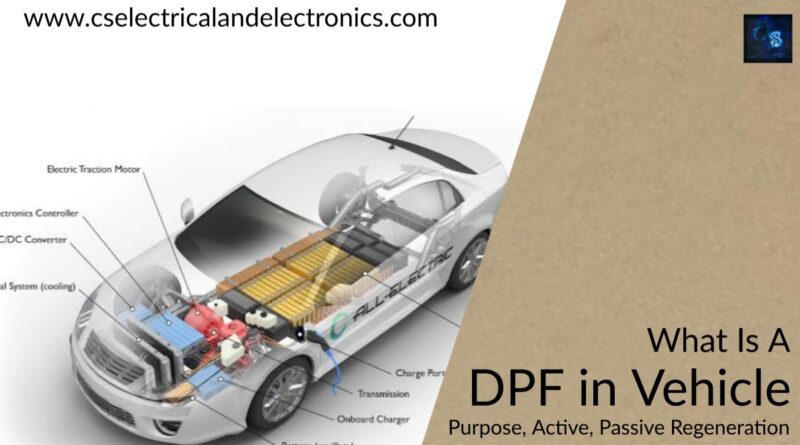What Is DPF In A Vehicle, Diesel Particulate Filter, Purpose, Working
Hello guys, welcome back to my blog. In this article, I will discuss what is DPF in a vehicle, diesel particulate filter, the purpose of DPF in a vehicle, the difference between passive generation and active generation.
If you have any doubts related to electrical, electronics, and computer science, then ask questions. You can also catch me on Instagram – CS Electrical & Electronics And Chetan Shidling.
Also, read:
- A Definitive Learner’s Guide For Electric Vehicle Technology Enthusiasts
- Top 20+ Electric Vehicle Projects With MATLAB Simulink File In 2022
- What Is BMS, Battery Management System, Working, Components
What Is DPF In A Vehicle
A diesel particulate filter (DPF) removes diesel particulate matter or soot from the exhaust gas of a diesel engine. Diesel particulate filters (DPF) are essential to the operation of diesel-fueled automobiles and trucks. Failure to keep these filters clean can have serious (and expensive) consequences for the vehicle.
What Is a Diesel Particulate Filter?
A diesel particulate filter, or DPF, is a particulate matter capture device for diesel engines that absorbs soot and ash. A honeycomb-shaped substrate made of ceramic material is typical of a DPF.
Diesel particulate filters catch and store exhaust soot, which must be burnt off periodically to regenerate the filter to reduce emissions from diesel automobiles. The regeneration process burns away any excess soot that has accumulated in the filter, preventing dangerous exhaust emissions and the black smoke that is typically seen when diesel engines accelerate.
To meet the EPA’s 2007 pollution limits, engine manufacturers utilize DPFs to trap particulate matter.
What Does a Blocked Diesel Particulate Filter?
Short trips at moderate speeds are frequently the source of clogged diesel particle filters. Vehicles traveling at low speeds on short travels are unable to meet the filter’s self-cleaning standards.
DPFs can also fail as a result of improper maintenance. A diesel particulate filter’s lifespan varies depending on its use. The Cummins ISX15 engine’s filter, for example, has a cleaning frequency of 400,000 to 600,000 miles, albeit it will need to regenerate before reaching that figure.
If DPFs are not properly maintained, they may fail sooner. Filter blockage can also be caused by using the improper type of oil, making performance changes, using bad-quality fuel, or driving the automobile on a low fuel level repeatedly.
When a DPF becomes clogged with soot, the key to keeping it in excellent working condition is to make sure it can regenerate itself (triggering the warning light). Passive and active generation are the two types of generation.
Passive Regeneration
The exhaust goes via the diesel oxidation catalyst (DOC) first, then through the diesel particulate filter, which captures soot particles inside the after-treatment device (ATD). When the temperature in the engine rises to the point where soot, or carbon, reacts with oxygen to form carbon dioxide, passive regeneration occurs. Carbon dioxide can pass through the filter because it is a gas.
Because ash is already a result of combustion, no amount of heat from the engine will be able to convert it. The ash will accumulate over time to the point that the filter must be physically removed and cleaned. After that, the filter can be reinstalled and reused.
Passive regeneration happens when the vehicle is driven regularly while under load, and the driver is unaware of it. It’s possible that the DPF won’t always stay clean throughout the workday, and the filter will need to be actively regenerated.
Active Regeneration
While passive regeneration is common in engine functioning, active regeneration requires the engine to take action. A truck carrying 80,000 pounds traveling down the highway, for example, will generate enough heat in the engine to cause a chemical reaction, which is passive regeneration.
When the engine isn’t producing enough heat, active regeneration takes place. This could happen in a truck that isn’t fully loaded, for example. When the amount of soot in the exhaust reaches a specific level, the engine injects fuel into the exhaust stream, which passes over the oxidation catalyst and oxidizes the fuel to produce heat. The heat generated by the oxidation of the fuel is then utilized to convert the soot to carbon dioxide.
Both active and passive regeneration occurs without the need for driver intervention. When the vehicle is moving, active regeneration might happen automatically. The temperature of the exhaust gas might reach 1500°F (800°C).
Except for some additional dashboard lamps, the driver is unaware of active regeneration. The high exhaust temp indicator will turn on the moment the after-treatment doser starts to inject, increasing the temperature in the after-treatment device, and is the most important sign to check for to detect if it is happening.
It might be costly to replace a diesel particulate filter. The cost of a new filter from a car manufacturer might range from $3,000 to $10,000.
It’s no secret that the value of vehicles and trucks declines as they get older. In many cases, the cost of replacing a DPF in an older, higher-mileage automobile or truck is greater than the vehicle’s worth. Cleaning a diesel particulate filter is far easier (and less expensive!) than replacing one, which is why understanding how these filters function and performing regular maintenance is so vital.
Be cautious if a parts supplier offers a lower price for a DPF—the filter must be the suitable type for your car. If you don’t, you’ll almost certainly wind up spending more on repairs.
To summarise, In older literature, the term “diesel particulate trap” is occasionally used interchangeably with “diesel particulate filter.” The term “trap” refers to a broader category of particle separation equipment. Other than filtration, industrial dust separation equipment uses a variety of particle deposition processes. Gravity settling, centrifugal separation, and electrostatic trapping are among the examples. Due to the small particle size and low density of diesel soot, none of these strategies could be used to reduce diesel PM emissions.
This was about “What Is DPF In A Vehicle“. I hope this article may help you all a lot. Thank you for reading.
Also, read:
- 10 Tips To Maintain Battery For Long Life, Battery Maintainance
- 10 Tips To Save Electricity Bills, Save Money By Saving Electricity
- 100 (AI) Artificial Intelligence Applications In The Automotive Industry
- 100 + Electrical Engineering Projects For Students, Engineers
- 1000+ Control System Quiz, Top MCQ On Control System
- 1000+ Electrical Machines Quiz, Top MCQs On Electrical Machines
- 1000+ MATLAB Simulink Projects For MTech, Engineering Students
- 50 Tips To Save Electricity At Home, Shop, Industry, Office
Author Profile
- Chetu
- Interest's ~ Engineering | Entrepreneurship | Politics | History | Travelling | Content Writing | Technology | Cooking
Latest entries
 All PostsApril 29, 2024Top 11 Free Courses On Battery For Engineers With Documents
All PostsApril 29, 2024Top 11 Free Courses On Battery For Engineers With Documents All PostsApril 19, 2024What Is Vector CANoe Tool, Why It Is Used In The Automotive Industry
All PostsApril 19, 2024What Is Vector CANoe Tool, Why It Is Used In The Automotive Industry All PostsApril 13, 2024What Is TCM, Transmission Control Module, Working, Purpose,
All PostsApril 13, 2024What Is TCM, Transmission Control Module, Working, Purpose, All PostsApril 12, 2024Top 100 HiL hardware in loop Interview Questions With Answers For Engineers
All PostsApril 12, 2024Top 100 HiL hardware in loop Interview Questions With Answers For Engineers








